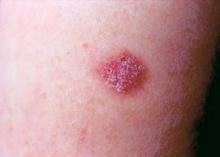LISBON – Nearly 30% of patients diagnosed with a first pathologically confirmed basal cell carcinoma will develop one or more additional primary basal cell carcinomas within 5 years.
This finding, from a comprehensive Dutch national cancer registry, has important implications for clinical practice, noted Dr. Sophie C. Flohil at the annual congress of the European Academy of Dermatology and Venereology.
"Based upon our results, we would like to recommend that all BCC [basal cell carcinoma] patients undergo annual follow-up visits with full-body skin examinations for at least 3 years after their first BCC diagnosis."
She presented a cohort study involving 2,483 consecutive unselected Dutch patients diagnosed with a first histological confirmed BCC during 2004.
During 5 years of prospective follow-up in PALGA, the Dutch nationwide network and registry of histo- and cytopathology, 29.2% of the patients were diagnosed with one or more additional primary BCCs, according to Dr. Flohil, a dermatology resident at Erasmus University, Rotterdam, the Netherlands.
More than one-third of patients who developed a second primary BCC within 5 years did so during the first 6 months after diagnosis of the first.
The cumulative risk during the first 6 months of follow-up was extraordinarily high at 11.2%, as compared with 13.9% through 1 year, 18.5% after 2 years, 22.1% at 3 years, 25.5% after 4 years, and 29.2% after 5 years, she said. This translates into an incidence rate of 25,318 cases per 100,000 person-years during the first half-year after diagnosis of a first primary tumor.
"We think that this could indicate that these second BCCs that occur in the first 6 months after a first BCC diagnosis were already present at the date of the first BCC diagnosis, but were somehow missed then by the dermatologist or the doctor they went to," she said.
Still, the incidence rate remained quite high during the first several years of follow-up: 15,737 cases per 100,000 person-years through the first year and 10,779 per 100,000 person-years after 2 years before tailing off to 8,752 per 100,000 person-years at 3 years.
In a multivariate analysis, men had an adjusted 30% increased risk of developing one or more subsequent BCCs, and patients aged 65-79 years had an 81% greater risk than those under age 50.
Dr. Flohil declared having no financial conflicts of interest.

